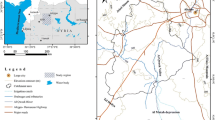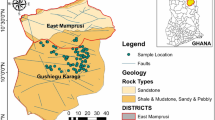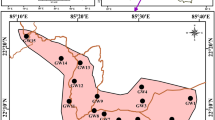Abstract
In rural areas of sub-Saharan Africa, groundwater is generally the only source of water for various needs, including drinking. This resource is, however, vulnerable to surface contamination that can alter its quality. Agriculture is the main activity generating pollutants in these areas. It is in this context that the present study assessed the geochemical processes controlling the mineralization of groundwater in the Bafou-Baranka agricultural area, in West Cameroon. It also assesses the suitability of this resource for consumption and irrigation. To achieve this, 06 representative sites were identified in the study area for sampling, physicochemical, and chemical analysis. The parameters analyzed include pH, temperature, electrical conductivity (EC), majors cations (Ca2+, Mg2+, Na+, K+, Fe2+), and majors anions (HCO3−, Cl−, SO42−, NO3−). The results indicate alkaline conditions with a dominance of Ca2+ and HCO3− ions, indicative of the alteration and dissolution of silicate minerals. The analysis of the geochemical signature by classical methods such as the Gibbs diagram confirms that the dominant process responsible for the mineralization of the waters studied is the alteration of silicates. This diagram also highlights the contribution of the precipitation domain in the total mineralization, indicating the youth of these waters and consequently their vulnerability to local climatic variability. The linear trend of TDS vs (NO3− + Cl−)/HCO3− and principal component analysis indicates the influence of non-natural sources on the aquifer system. These have the smallest contribution to groundwater chemistry. Therefore, the influence of anthropogenic sources in groundwater chemistry is masked on Bafou-Baranka area by geogenic factors. According to the entropy weighted groundwater quality index, and the EC vs Na+ hazard, all analyzed samples are suitable for drinking and irrigation. However, the Fe2+ content is high in the studied samples; therefore, activated carbon filters are needed to provide safe domestic water for drinking purposes. The overuse of fertilizers for agriculture should also be controlled to keep these waters safe.





Similar content being viewed by others
Data availability
The datasets generated during and/or analyzed during the current study are available from the corresponding author on reasonable request.
References
Akakuru OC, Akudinobi B, Iheanyichukwu AO, Okechukwu SO, Akakuru OU (2021) Hydrogeochemical facies and pollution status of groundwater resources of Owerri and environs, Southeastern Nigeria. Environ Monit Assess. https://doi.org/10.1007/s10661-021-09364-9
Ako AA, Takem Eyong GE, Shimada J, Koike K, Hosono T, Ichiyanagi K, Richard A, Tandia BK, Nkeng GE, Ntankouo NR (2014) Nitrate contamination of groundwater in two areas of the Cameroon Volcanic Line (Banana Plain and Mount Cameroon area). Applied Water Science. https://doi.org/10.1007/s13201-013-0134-x
Alizadeh Z, Yazdi J, Moridi A (2018) Development of an entropy method for groundwater quality monitoring network design. Environ Proces. https://doi.org/10.1007/s40710-018-0335-2
Aravinthasamy P, Karunanidhi D, Subba Rao N, Subramani T, Srinivasamoorthy K (2020) Irrigation risk assessment of groundwater in a non-perennial river basin of South India: implication from irrigation water quality index (IWQI) and geographical information system (GIS) approaches. Arab J Geosci. https://doi.org/10.1007/s12517-020-06103-1
Deepali M, Malpe DB, Karunanidhi D, Patil PD, Li P (2020) Hydrogeochemical evaluation, suitability, and health risk assessment of groundwater in the watershed of Godavari basin, Maharashtra, Central India. Environ Sci Poll Research. https://doi.org/10.1007/s11356-020-10032-7
Eneke Takem G, Chandrasekharam D, Ayonghe SN, Thambidurai P (2009) Contamination characteristics of alluvial groundwater from springs and bore wells in semi-urban informal settlements of Douala, Cameroon, Western Africa. Environ Earth Sci 61:287–298. https://doi.org/10.1007/s12665-009-0342-8
Fisher RS, Mulican WFIII (1997) Hydrochemical evolution of sodium-sulfate and sodium-chloride groundwater beneath the Northern Chihuahuan Desert, Trans-Pecos, Texas, USA. Hydrogeol J 10:455–474
Gibbs RJ (1970) Mechanisms controlling world water. chemistry. Science 17:1088–1090. https://doi.org/10.1126/science17039621088
Gountie Dedzo M, Njonfang E, Nono A, Kamgang P, Zangmo TG, Kagou DA, Nkouathio DG (2012) Dynamic and evolution of the Mounts Bambouto and Bamenda calderas by study of ignimbritic deposits (West-Cameroon, Cameroon Line). Syllabus Review 3(2012):11–23
Gugulothu S, Subbarao N, Das R, Dhakate R (2022) Geochemical evaluation of groundwater and suitability of groundwater quality for irrigation purpose in an agricultural region of South India. Appl Water Sci. https://doi.org/10.1007/s13201-022-01583-w
Kamtchueng BT, Fantong WY, Wirmvem MJ, Tiodjio RE, Takounjou AF, Ndam Ngoupayou JR, Kusakabe M, Zhang J, Ohba T, Tanyileke G, Hell JV, Ueda A (2016) Hydrogeochemistry and quality of surface water and groundwater in the vicinity of Lake Monoun, West Cameroon: approach from multivariate statistical analysis and stable isotopic characterization. Environ Monit Assess. https://doi.org/10.1007/s10661-016-5514-x
Karunanidhi D, Aravinthasamy P, Deepali M, Subramani T, Bellows CB, Li P (2020) Groundwater quality evolution based on geochemical modeling and aptness testing for ingestion using entropy water quality and total hazard indexes in an urban-industrial area (Tiruppur) of Southern India. Environ Sci Pollut Res. https://doi.org/10.1007/s11356-020-10724-0
Kaiser HF (1958) The Varimax criteria for analytical rotation in factor analysis. Psychometrika 23:187–200
Kengni L, Mboussop AN, Njueya Kopa A, Tankou CM, Tematio P, Ndam Ngoupayou JR (2019) Rainfall variability on the southern slope of the Bambouto mountain (West-Cameroon) and impact on the crop cultivation calendar. J Afr Earth Sci. https://doi.org/10.1016/jjafrearsci201903020
Kengni L, Simo Pieam J, Temgoua E, Tematio P, Ndam Ngoupayou JR, Boeglin JL (2013) Hydrogeochemical processes in the southern slope of the Bambouto Mountain (West-Cameroon). Intl J Eng Sci Technol
Kouakou VK, Obuabie E, Banning A, Wohnlich S (2017) Hydrochemical characteristics of groundwater and surface water for domestic and irrigation purposes in Vea catchment, Northern Ghana. Environ Earth Sci. https://doi.org/10.1007/s12665-017-6490-3
Li P, Qian H (2018) Water resources research to support a sustainable China. Inter J Water Resour Dev. https://doi.org/10.1080/0790062720181452723
Li Q, Zhang H, Guo S, Fu K, Liao L, Xu Y, Cheng S (2019) Groundwater pollution source apportionment using principal component analysis in a multiple land-use area in southwestern China. Environ Sci Pollut Res. https://doi.org/10.1007/s11356-019-06126-6
Nguedia Djatsa K, Ndongo B, Ntankouo Njila R, Kagou Dongmo A (2022) Hydrodynamic and microbiological characterisation of free ground water in the city of Bafoussam, (West Cameroon). Water Pract Technol. https://doi.org/10.2166/wpt.2022.057
Nono A, Likeng JDH, Wabo H, Tabue Youmbi G, Biaya S (2009) Influence de la nature lithologique et des structures géologiques sur la qualité et la dynamique des eaux souterraines dans les hauts plateaux de l’Ouest-Cameroun. Int J Biol Chem Sci 3(2). https://doi.org/10.4314/ijbcs.v3i2.44516
Ntangmo Tsafack H, Azeufack J, Kenfack S, Joko Tamouf S, Tchoffo AM, Tonssie FF, Wamba F, Temgoua E (2022) Physicochemical, bacteriological and parasitological quality of water used to wash vegetables in Dschang, West Cameroon: Health Risk Assessment. J Health Environ Res. https://doi.org/10.11648/jjher2022080111
Piper AM (1944) A graphical procedure in the geochemical interpretation of water analyses. Trans Am Geophys Union 25:914–928
Rahmati O, Samani AN, Nariman M, Mahdavi M (2015) Assessment of the contribution of N-fertilizers to nitrate pollution of groundwater in western Iran (case study: Ghorveh-Dehgelan aquifer). Water Qual Expo Health. https://doi.org/10.1007/s12403-014-0135-5
Ravikumar PR, Somashekar RK, Angami M (2011) Hydrochemistry and evaluation of groundwater suitability for irrigation and drinking purposes in the Markandeya River basin, Belgaum District, Karnataka State, India. Environ Monit Assess. https://doi.org/10.1007/s10661-010-1399-2
Saravanan K, Srinivasamoorthy K, Prakash R, Gopinath S, Suma CS (2015) An evaluation of hydrogeochemistry of groundwater in upper Vellar sub-basin using mineral stability and solute transport modeling Inter confer water Reso, coastal and ocean. Eng Aquat Proced 4:1119–1125. https://doi.org/10.1016/jaqpro201502142
Srinivasamoorthy K, Chidambaram S, Prasanna MV, Vasanthavihar M, Peter J, Anandhan P (2008) Identification of major sources controlling groundwater chemistry from a hard rock terrain—a case study from Mettur taluk, Salem District, Tamil Nadu. J Earth Syst Sci. https://doi.org/10.1007/s12040-008-0012-3
Subba Rao N, Deepali M, Dinakar A, Chandana I, Sunitha B, Ravindra B, Balaji T (2017) Geochemical characteristics and controlling factors of chemical composition of groundwater in a part of Guntur district, Andhra Pradesh, India. Environ Earth Sci. https://doi.org/10.1007/s12665-017-7093-8://
Subba Rao N, Dinakar A Sravanthi M, Karuna Kumari B (2021) Geochemical characteristics and quality of groundwater evaluation for drinking, irrigation, and industrial purposes from a part of hard rock aquifer of South India. Environ Sci Pollut Res. https://doi.org/10.1007/s11356-021-12404-z
Tontsa L, Temgoua E, Bertrand G, Kengni L, Makaya Mvoubou MC, Njueya Kopa A, Mba FF (2023) Environmental factors controlling contamination of alternative water supply points in the Lefock semi-urban watershed, Cameroon Western Highlands. Environmental Earth Sciences 82:17. https://doi.org/10.1007/s12665-022-10699-w
USSLS (1954) Diagnosis and improvement of saline and alkali soils United States Soil Salinity Laboratory Staff, US Department of Agriculture, Washington, 69–81, Agriculture handbook 60
Wagh VM, Panaskar DB, Jacobs JA, Mukate SV, Muley AA, Kadam AK (2019) Influence of hydrogeochemical processes on groundwater quality through geostatistical techniques in Kadava River basin, Western India. Arab J Geosci https://doi-orglibproxyvikolt/101007/s12517-018-4136-8
WHO (2017) Guidelines for drinking-water quality. World Health Organization, Geneva
Wu H, Chen J, Qian H, Zhang X (2015) Chemical characteristics and quality assessment of groundwater of exploited aquifers in Beijiao water source of Yinchuan, China: a case study for drinking, irrigation, and industrial purposes. J Chem. https://doi.org/10.1155/2015/726340
Author information
Authors and Affiliations
Contributions
All authors contributed to the study’s conception and design. Material preparation, data collection, and analysis were performed by Lauric Tontsa, Lucas Kengni, Adoua Njueya Kopa, Emile Temgoua, Orline Lesley Mbianda Nfong-Ya, Carlos Foko Tamba, and Raoul Merlin Ndonbou. The first draft of the manuscript was written by Lauric Tontsa and all authors commented on previous versions of the manuscript. All authors read and approved the final manuscript.
Corresponding author
Ethics declarations
Ethics approval
Not applicable.
Consent to participate
Not applicable.
Consent for publication
Not applicable.
Competing interests
The authors declare no competing interests.
Additional information
Responsible Editor: Broder J. Merkel
Highlights
• Groundwater chemistry is mainly controlled by natural factors.
• The current anthropogenic contamination is very low.
• Groundwater can be used for drinking and irrigation.
• Fe2+ concentration is above the WHO standard due to geogenic processes.
Rights and permissions
Springer Nature or its licensor (e.g. a society or other partner) holds exclusive rights to this article under a publishing agreement with the author(s) or other rightsholder(s); author self-archiving of the accepted manuscript version of this article is solely governed by the terms of such publishing agreement and applicable law.
About this article
Cite this article
Tontsa, L., Kengni, L., Njueya Kopa, A. et al. Geochemical characteristics and quality of groundwater in a rural sub-Saharan context. A case study of Bafou-Baranka on Bambouto Mountain, West Cameroon. Arab J Geosci 16, 203 (2023). https://doi.org/10.1007/s12517-023-11287-3
Received:
Accepted:
Published:
DOI: https://doi.org/10.1007/s12517-023-11287-3




